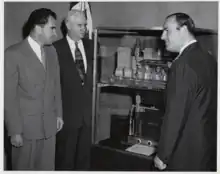Mosler Safe Company
The Mosler Safe Company was an American multinational manufacturer of security equipment specializing in safes and bank vaults. In 2001, the company was acquired by Diebold Inc. after going bankrupt.
 | |
.jpg.webp) The Mosler Safe Company factory, Hamilton, circa 1894. | |
| Formerly | Mosler Safe & Lock Company |
|---|---|
| Industry | Security equipment manufacturing |
| Predecessor | Mosler, Bahmann & Company |
| Founded | 1874 |
| Founders |
|
| Defunct | 3 August 2001 |
| Fate | Bankrupted, acquired by Diebold Inc. |
| Headquarters | , U.S. |
| Website | mosler.com at the Wayback Machine (archived 2001-04-18) |
History
In 1867, Gustave Mosler and Fred Bahmann founded Mosler, Bahmann & Company in Cincinnati, Ohio. In 1874, after Gustave's death, the Mosler family had a falling out with Bahmann. The family left Mosler, Bahmann & Company to start the Mosler Safe & Lock Company. Both companies remained in Cincinnati until the 1890s. When Mosler Safe & Lock Co. outgrew its original factory in 1891, it relocated to Hamilton, where it remained until its bankruptcy. Mosler, Bahmann & Company remained in business until around 1898.[1]
Mosler was controlled by its founding family until 1967, when they sold it to American Standard Companies.[2] American Standard then sold the division to a group of Mosler managers and outside investors in 1986.[3]: 48
After 134 years in business, Mosler filed Chapter 11 bankruptcy in August 2001, citing continuing debt problems, and ceased operations shortly thereafter. Diebold subsequently announced programs to support former Mosler customers[4] and bought most of the original company in bankruptcy court a few months later.[5]
Products

Mosler's safes and vaults were renowned for their strength and precise manufacturing. Several Mosler vaults installed in Hiroshima's Mitsui Bank building prior to WWII survived the nuclear attack, a fact the company widely publicized in its marketing.[4][6] When the U.S. government began building bunkers and silos during the Cold War, Mosler became the contractor for blast doors. One of them, installed at the Atomic Energy Commission's Oak Ridge National Laboratory,[3]: 47 weighed approximately 138 tons including the frame.
Mosler built the vault formerly used to display and store the Charters of Freedom: the US Constitution, Declaration of Independence, and the Bill of Rights. Mosler also built the gold vaults for the United States Bullion Depository at Fort Knox.[1][7] Despite the weight, each 58-ton blade could be opened and closed manually by one person.[8][9]
References
- Wood, Roy (1 August 2001), "Mosler employees stunned by closing", The Cincinnati Post, archived from the original on 5 November 2004, retrieved 2 September 2007
- "Mosler Quits as a Director Of American Standard, Inc.", New York Times, 13 February 1968, retrieved 18 November 2022
- Piland, Richard N. (4 May 2015), Hamilton's Industrial Heritage, Arcadia Publishing, ISBN 978-1-4396-5115-5, retrieved 18 August 2023
- Mosler Inc. to Cease All Operations, Diebold to Support Customers in Wake of Mosler's Liquidation, Five Star Security Services, 8 August 2001, archived from the original on 14 April 2013, retrieved 2 September 2007
- "Diebold to purchase Mosler assets", ATM Marketplace, 6 December 2001, retrieved 21 November 2022
- Mosler and the Cold War, The Lane Libraries, archived from the original on 6 February 2012, retrieved 1 July 2013
- Tim McKeough (19 November 2015), "From Financial Guru to Brooklyn Ceramist", New York Times, retrieved 21 September 2020
- Elliot Carter (6 March 2017), "Found: A Miniature Working Model of the National Archives Vault", Atlas Obscura, retrieved 21 September 2020
- Kratz, Jessie (29 June 2020), "The Mosler Model", Pieces of History, National Archives, retrieved 14 December 2022